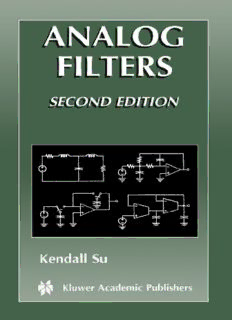
Analog Filters PDF
Preview Analog Filters
ANALOG FILTERS, SECOND EDITION This page intentionally left blank ANALOG FILTERS, SECOND EDITION Kendall Su KLUWER ACADEMIC PUBLISHERS NEW YORK,BOSTON, DORDRECHT, LONDON, MOSCOW eBookISBN: 0-306-47953-2 Print ISBN: 1-4020-7033-0 ©2003 Kluwer Academic Publishers NewYork, Boston, Dordrecht, London, Moscow Print ©2002 Kluwer Academic Publishers Dordrecht All rights reserved No part of this eBook maybe reproducedor transmitted inanyform or byanymeans,electronic, mechanical, recording, or otherwise, without written consent from the Publisher Created in the United States of America Visit Kluwer Online at: http://kluweronline.com and Kluwer's eBookstore at: http://ebooks.kluweronline.com Contents Preface xiii 1 INTRODUCTION 1 1.1 Preliminary Remarks 1 1.2 The Analog Filter 3 1.3 Ideal and Approximate Filter Characteristics 4 1.4 MATLAB 7 1.5 Circuit Analysis 9 1.6 Normalization and Denormalization - Scaling 13 1.6.1 Frequency scaling 13 1.6.2 Impedance scaling 14 1.6.3 Normalization and denormalization 16 1.7 Steps Involved in the Design of Filters 16 Problems 20 2 THE APPROXIMATION 25 2.1 The Butterworth Lowpass Characteristic 26 2.1.1 The normalized Butterworth lowpass characteristic 27 2.1.2 Using a normalized Butterworth lowpass characteristic for a filtering requirement 29 2.2 The Chebyshev Lowpass Characteristic 30 2.2.1 The Chebyshev polynomial 31 2.2.2 The Chebyshev lowpass characteristic 34 2.3 Other Chebyshev-Related Characteristics 37 2.4 The Elliptic-Function Filter Characteristic 39 2.5 Comparison of Standard Lowpass Characteristics 41 2.6 Summary 43 Problems 43 vi Contents 3 NETWORK FUNCTIONS 49 3.1 General Procedure 49 3.2 Network Functions for Butterworth filters 53 3.3 Network Functions for Chebyshev Filters 58 3.4 Network Functions for Elliptic-Function Filters 62 3.5 Bessel-Thomson Filter Functions 66 3.6 Delay Equalization 71 3.7 Summary 74 Problems 74 4 FREQUENCY TRANSFORMATION 77 4.1 Lowpass-to-Highpass Transformation 78 4.2 Lowpass-to-Bandpass Transformation 80 4.3 Lowpass-to-Bandreject transformation 86 4.4 Summary 88 Problems 88 5 PROPERTIES AND SYNTHESIS OF PASSIVE NETWORKS 93 5.1 The Driving-Point Function of a Passive Oneport - the Positive Real Function 93 5.2 The Driving-Point Function of a Lossless Oneport - the Lossless Function 94 5.2.1 Properties of a lossless function 94 5.2.2 Foster’s expansion of a lossless function 96 5.2.3 Foster’s realizations of a lossless function 99 5.2.4 Removal of poles at infinity 100 5.2.5 Removal of poles at the origin 104 5.2.6 Removal of finite nonzero poles 106 5.2.7 Mixed canonic realization 107 5.2.8 Noncanonic realization 108 5.3 Properties of Lossless Twoports 110 5.4 LC Ladder Twoport 112 5.5 Foster’s Preamble 115 5.6 Summary 118 Problems 118 Contents vii 6 SINGLY-TERMINATED LC LADDERSs 123 6.1 LC Ladder with a Current Source 123 6.1.1 Transmission zeros at the origin and infinity 125 6.1.2 Zero shifting 131 6.1.3 LC ladder with finite nonzero transmission zeros 133 6.2 LC Ladder with a Voltage Source 136 6.3 Other Singly-Terminated Orientations 139 6.4 Summary 140 Problems 141 7 DOUBLY-TERMINATED LC LADDERS 145 7.1 Basic Formulation 145 7.2 LC Ladders with Equal Terminations 149 7.3 LC Ladder with Unequal Terminations 158 7.4 A Doubly-Terminated Filter Used in Reverse 163 7.5 Summary 167 Problems 167 8 SENSITIVITY 171 8.1 Definition of Sensitivity 173 8.2 Properties of First-Order Sensitivity 174 8.3 Sensitivities of Network Performance 175 8.4 Sensitivity Calculation 177 8.5 Unnormalized Sensitivity 180 8.6 Multiparameter and Statistical Sensitivities 181 8.7 A Case for Low Sensitivity of Passive Filters 182 8.8 Summary 184 Problems 184 9 BASICS OF OP AMP-RC CIRCUITS 187 9.1 Comparison of Passive and Active Filters 187 9.2 The Operational Amplifier (Op Amp) 190 9.3 Some Simple Op Amp Circuits 192 9.4 First-Order Sections 195 viii Contents 9.5 RC Single-Op Amp Circuit Relationships 197 9.5.1 Finite-gain single-op amp configuration 197 9.5.2 Infinite-gain single-op amp configuration 200 9.6 Gain Adjustments 200 9.6.1 Gain reduction 201 9.6.2 Gain enhancement 201 9.7 RC-CR Transformation 204 9.8 Types of Biquads 206 9.9 Summary 207 Problems 207 10 OP AMP-RC BIQUAD CIRCUITS 217 10.1 Sallen-Key Biquads 217 10.1.1 Lowpass biquad 218 10.1.2 Highpass biquad 223 10.1.3 Bandpass biquad 225 10.1.4 Bandreject biquad 228 10.2 Infinite-Gain Multiple-Feedback (MFB) Biquads 230 10.2.1 Lowpass biquad 230 10.2.2 Highpass biquad 233 10.2.3 Bandpass biquad 233 10.2.4 Bandreject and allpass biquad 237 10.3 Two-Integrator Biquads 238 10.3.1 The Kerwin-Huelsman-Newcomb (KHN) biquad 239 10.3.2 The Tow-Thomas biquad 243 10.3.3 The Fleischer-Tow biquad 245 10.4 Summary 247 Problems 247 11 HIGH-ORDER OP AMP-RC FILTERS 253 11.1 Cascaded Biquads 253 11.1.1 Gain allocation 258 11.1.2 Pole-zero pairing 263 11.1.3 Biquad sequencing 264 Contents ix 11.2 The State-Variable Method of Realization 265 11.2.1 Realization of all-pole transfer functions 265 11.2.2 Realization of general transfer functions 266 11.2.3 Realization using lossy integrators 270 11.3 Lowpass-to-BandpassTransformation 274 11.3.1 Coupled biquads with infinite Q 274 11.3.2 Bandpass filters using the primary resonator blocks 276 11.4 Internal Gain Change 277 11.5 Summary 280 Problems 281 12 OP AMP-RC SIMULATION OF PASSIVE FILTERS 285 12.1 Some Active Twoports 286 12.2 The Generalized Impedance Converter (GIC) 288 12.3 Simulation of Inductances in an LC Ladder 291 12.3.1 Simulation of grounded inductors 291 12.3.2 Simulation of floating inductors 292 12.3.3 Simulation of groups of inductors 295 12.4 Simulation Using Frequency-Dependent Negative Resistances (FDNRs) 299 12.5 Functional Simulation of Passive Filters 301 12.5.1 The leap-frog simulation 302 12.5.2 Leap-frog realization of lowpass LC ladder 305 12.5.3 Leap-frog realization of bandpass filters using biquads 305 12.5.4 Leap-frog realization of bandpass filters using integrators 307 12.5.5 Simulation of a special bandpass filter 309 12.6 Summary 314 Problems 314 13 SWITCHED-CAPACITOR FILTERS 321 13.1 An Introduction 322 13.2 Simulation of Resistors by Switched Capacitors 323
Description: